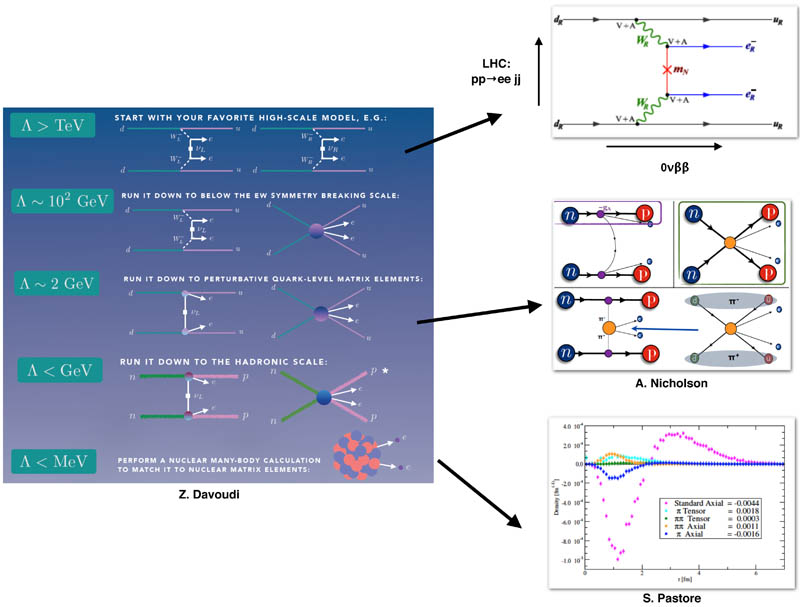 |

Experimental groups worldwide are working to develop detectors that may allow the observation of neutrinoless double-beta decay in isotopes such as 76Ge, 136Xe, 130Te, and 82Se. Observation would have far reaching consequences: it would prove that lepton number is violated, demonstrate that neutrinos are Majorana particles, and provide information about the neutrino-mass generation mechanism and possibly about baryogenesis. The decay rate, however, depends on matrix elements that cannot be measured. These depend in turn on complex nuclear structure but may also reflect particle and hadronic physics since the decay can proceed through the exchange of either a light Majorana neutrino or exotic still-undiscovered heavy particles, in which case both particle and hadronic physics will be involved. Clearly, in order to draw conclusions about the mechanism and parameters of lepton number violation from either a positive or null experimental result, one must compute the matrix elements with reasonable accuracy.
This five-week program brought together experts in nuclear structure, lattice QCD, hadronic physics, BSM physics, and experiment to address outstanding problems associated with the matrix elements that govern neutrinoless double-beta decay. The program hosted three intense two-day workshops, two on its own and one through the independent workshop 17-67W on lattice QCD. The opening workshop brought experimentalists together with theorists to discuss all the issues associated with double-beta decay. The workshop in week two, a meeting of the Topical DOE Nuclear Theory Collaboration for Double-Beta Decay and Fundamental Symmetries, featured reports on nearly the entire range of ab-initio many-body methods.
Talks and discussions during the program summarized progress along several lines of research.
The major issues and questions included:
What are the broader implications of neutrino-less double-beta decay searches for new physics scenarios? In particular, several presentations discussed the interplay with other neutrino experiments, cosmology, and high-energy probes of lepton number violation.
Since neutrinoless double-beta decay involves a number of quite distinct physical scales (the scale of lepton number violation, the scale of weak interactions, the hadronic and nuclear scales), effective field theory (EFT) can be used to organize the calculation of matrix elements. A number of talks discussed the EFT approach to double-beta decay, both in the context of heavy- particle and light-neutrino physics, and the interface of nuclear structure and lattice QCD.
Thus far ab-initio nuclear-structure calculations have dealt mainly with the Hamiltonian and spectra. Several talks and discussions focused on plans to compute processes such as two-neutrino double beta decay, single beta decay and neutrino-nucleus scattering, all of which are more closely related to neutrinoless double-beta decay.
One of the largest sources of uncertainty in matrix-element calculations goes by the sobriquet "the renormalization of gA," i.e. a tendency to over-predict β-decay and two- neutrino double-beta decay matrix elements. In modern language any quenching must be due to either neglected correlations or many-body currents. The big question is then: does whatever is responsible for this "gA quenching" also quench neutrinoless double-beta decay?
At the program preliminary results were presented indicating that two-body currents do not quench gA in light nuclei, but may in heavier ones. Ab initio nuclear theory and chiral EFT will soon give us the ability to provide a complete answer to the big question, at least in light nuclei.
Matrix-element calculations must be tested and benchmarked. Concrete suggestions were put forward for comparing calculations of matrix elements results fro single and double-beta decay in light nuclei (that do not actually undergo observable double beta decay).
Finally, it was gratifying for the organizers to see that a number of scientists who had only thought briefly about double-beta decay or were just beginning (or considering) research projects on the subject came away with much clearer ideas about how to proceed, and with a thorough education. They also saw collaborations form between experts in heavy nuclei and in light nuclei, and between many-body and hadronic theorists, to address (for example) the "quenching of gA" and possible many-body enhancement of sub-leading operators in chiral effective field theory. The interaction and collaborations fostered by this INT program should bear fruit in the years to come.
|


